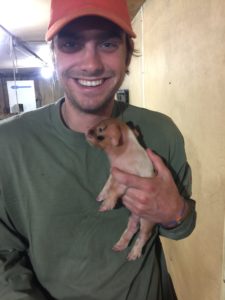Tuesday, May 16 was an interesting day for the Farm crew, but especially for the guys I live with. First, Reid, Parker, and I woke up at 6:30 to artificially inseminate cows on the Sweeney Ranch. Once we herded the cattle and found the two females we needed, they had to be put into a head chute. Neither cow really wanted to be in there, so there was some trouble. Once the first cow was in, there was an issue finding the right parts, and she very forcefully broke through the chute scaring everyone in the barn but the relaxed Dave Sweeney. After that, it went fairly well. Once the second bovine was in the chute, she went extremely quick. After some unexpected car troubles, we arrived at Morris’s for breakfast at 7:45 and ate a classic Diane breakfast consisting of bacon and eggs. Once we were stuffed, we headed over to the Friest Farm.
Instead of riding tractors like we did Saturday, we had the opportunity to see their pig barn. Initially I was skeptical. Pig barns are a hot-button topic in agriculture, especially in a state like Iowa where there are hundreds of these barns in one single county. Some animal rights activists go crazy about the supposed inhumane conditions in these barns. They claim that the environments are too stressful on the pigs, they can easily get hurt chewing on the bars of their constricting metal cages, and sometimes they can even turn cannibalistic. Going into the barns, we couldn’t have had a better guide. Brent, who is a rather open guy, told us everything I could have wanted to know about how he raised his swine and how they were treated.
First, we saw the mill where the pig feed was created. One of the things Brent was most proud of on the Friest farm is their ability produce almost everything on site. They grow the corn to use for feed, make the feed themselves in their mill, and use the pig manure to put on their crops. One of the questions that came up in the food mill was about the use of antibiotics. Many claim that the pigs are being pumped with harmful antibiotics daily, and that these antibiotics not only effect their lives, but also effect human lives after consumption. Brent assured us this isn’t true. They only put in what they need to keep the pigs safe and happy. Plus, the antibiotics have no bearing on humans after consumption. Some, such as amoxicillin, are used on all types of humans and animals.
After the feed mill, we went to see the gestation crates. This is also a very sensitive issue. The crates are wide enough for the hogs to fit in comfortably, but they can’t turn around. Although this seems bad at first, once you enter and begin to look around it isn’t. In my opinion, the quality of life for these pigs wasn’t terrible. They get fed, are given plenty of water, and they are kept in a comfortable climate. The pigs in these cages aren’t treated bad. They are Brent’s property and his livelihood, so he keeps them in good enough condition to sell. Instead of being harsh and cruel, he genuinely tries his hardest to care for the pigs and ensure they are in good enough shape to be sent to market.
Next, we went inside one of my favorite places of all time, the piglet barn. Here, mothers lay in gestation crates while their offspring ran happily around them either feeding or playing. Some activists claim the gestation creates are extremely inhumane. They say the mothers don’t have room to move around and they are kept in a position where they can only stand or lay down. But, as Brent explained, this is for the safety of the piglets and the mother. A lot of babies die because they are stepped or laid on. The crates are meant to maximize the health of the baby pigs. Each mother pig is given ample food and water while she is nursing, and the piglets have unobstructed access to their mother’s udders as well as milk put in their spaces. Not only did we get to see the piglets, but we also got to hold them. In my opinion, this was one of the best moments of our trip. Some didn’t like the human contact, but others loved being held.
I think one of the biggest problems pig barns face is the lack of communication between farmers and consumers. Because of the biosecurity issue, most people aren’t allowed in pig barns to experience them firsthand. Before going into the Friest barn I was worried about what I might see. Most of the things I’ve heard about barns are horrible. I expected dead and tailless pigs everywhere. However, this wasn’t anywhere close to reality. As I said earlier, the pigs are Brent’s livelihood. They are in good hands. If anything is abnormal or the pig is injured, he can’t be sold; that’s money out of the Friest’s pockets. As we see a few more hog barns in the upcoming weeks it will be easier to compare what I saw on the Friest Farm. But as of now, I see nothing wrong with the way hogs are raised in large, independent barns. Brent said that every barn is different, and that no states have the same style, volume, or methods to raising pigs. Because of this, people need to look at pigs on a local level. There can’t be any catchall policies is pig farming.

